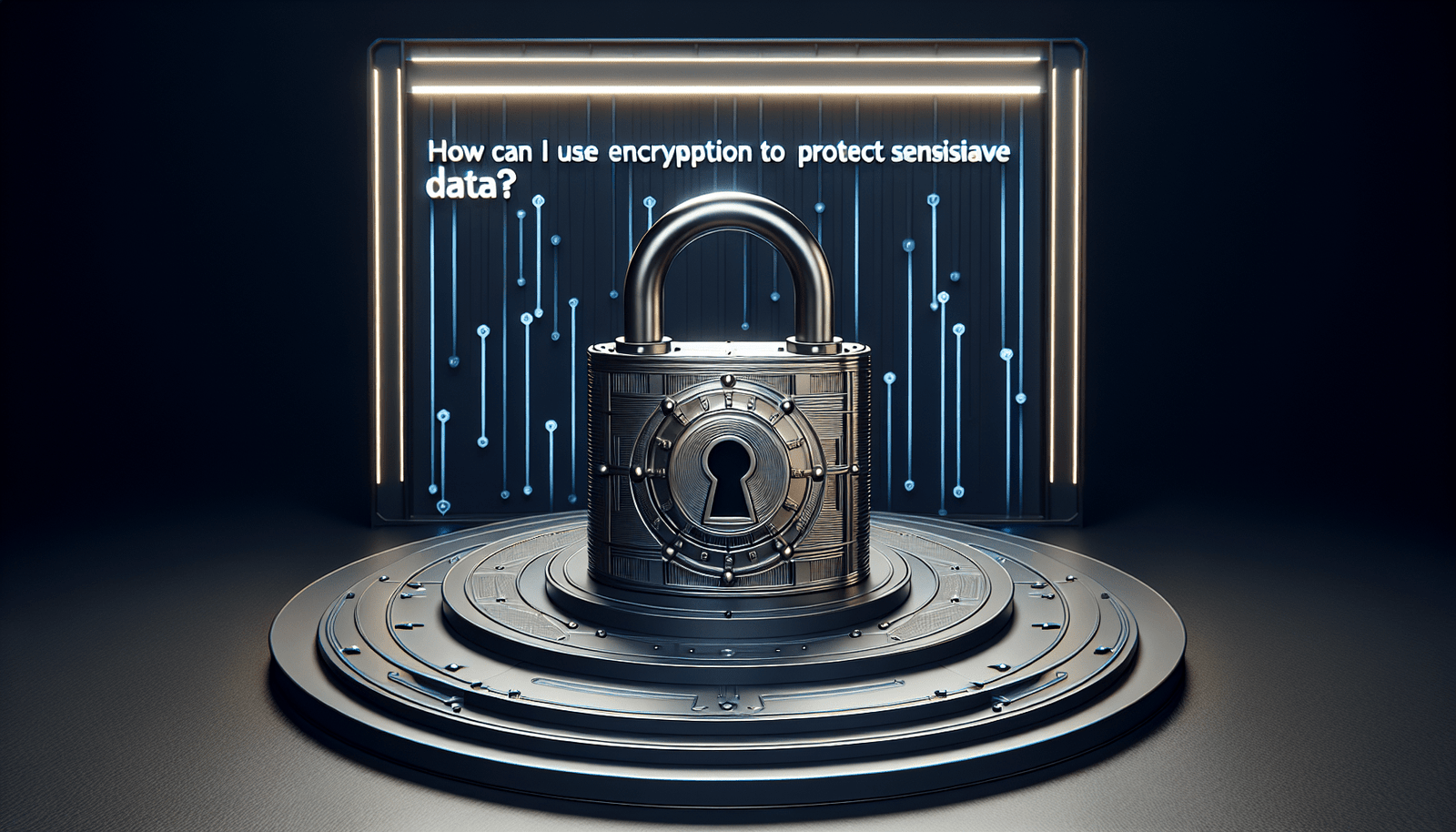
In today’s ever-evolving digital landscape, the protection of sensitive data has become a paramount concern. With cyber threats on the rise, organizations and individuals alike are seeking robust security measures to safeguard their valuable information. Encryption emerges as a powerful solution, leveraging advanced algorithms to encode data in a way that only authorized parties can decipher. By implementing encryption techniques, you can fortify your data against unauthorized access, ensuring its confidentiality and integrity. This article explores the fundamental aspects of encryption and provides practical insights on how you can harness its potential to protect sensitive data effectively.
Encryption Basics
What is encryption?
Encryption is a method used to protect sensitive data by scrambling it into ciphertext, which can only be deciphered with the use of a decryption key. It is a fundamental tool in the realm of cybersecurity and plays a critical role in safeguarding information from unauthorized access or theft. By utilizing encryption, organizations can ensure the confidentiality, integrity, and authenticity of their data.
How does encryption work?
Encryption works on the principle of converting plaintext data into unreadable ciphertext. This process involves the use of mathematical algorithms and encryption keys. The encryption algorithm determines how the encryption and decryption process is executed, while the encryption key is a unique sequence of characters that enables the encryption and decryption of the data. When the data is encrypted, it becomes unreadable to anyone without the corresponding decryption key.
Types of encryption
There are primarily three types of encryption techniques commonly used: symmetric encryption, asymmetric encryption, and hybrid encryption.
Symmetric encryption
Symmetric encryption, also known as secret key encryption, utilizes a single key for both encryption and decryption of the data. This key is shared between the communicating parties, ensuring secure transmission and reception of the encrypted information. However, the challenge with symmetric encryption is securely sharing the key without it falling into the wrong hands.
Asymmetric encryption
Asymmetric encryption, also referred to as public key encryption, involves the use of a pair of keys – a public key and a private key. The public key is freely distributable and used for encrypting the data, while the private key is kept securely by the data recipient for decrypting the encrypted information. Asymmetric encryption provides enhanced security as the private key never needs to be shared.
Hybrid encryption
Hybrid encryption combines both symmetric and asymmetric encryption to leverage their advantages while mitigating their individual drawbacks. In this approach, the symmetric key is used for encrypting the bulk of the data to ensure efficiency, while the asymmetric key is used to encrypt and securely transmit the symmetric key. Hybrid encryption strikes a balance between security and performance, making it an optimal solution for many encryption scenarios.

Choosing the Right Encryption Algorithm
Symmetric encryption
Symmetric encryption algorithms, such as Advanced Encryption Standard (AES) and Data Encryption Standard (DES), are widely used for securing data at rest and in transit. These algorithms offer high-speed performance and are well-suited for encrypting large volumes of data. However, symmetric encryption requires secure key distribution and management to prevent unauthorized access.
Asymmetric encryption
Asymmetric encryption algorithms, including RSA and Elliptic Curve Cryptography (ECC), provide secure communication channels through the use of a public key and a private key. These algorithms are particularly valuable for secure key exchange, digital signatures, and secure communication between multiple parties. Asymmetric encryption offers a higher level of security compared to symmetric encryption but is more computationally intensive.
Hybrid encryption
Hybrid encryption combines the strengths of both symmetric and asymmetric encryption. It addresses the challenge of securely transmitting the symmetric key in symmetric encryption while utilizing the efficiency of symmetric encryption for bulk data encryption. Hybrid encryption is a popular choice for secure communication over the internet, as it provides a balance between security and performance.
Securing Data at Rest
Understanding data at rest
Data at rest refers to data stored in physical or electronic storage media, such as hard drives, solid-state drives, and databases, when it is not actively being used or transmitted. Securing data at rest is crucial to protect it from unauthorized access in case of breaches or theft. Encryption plays a vital role in ensuring the confidentiality and integrity of data at rest.
Encrypting files and folders
Encrypting files and folders involves applying encryption algorithms to the data contained within them. This process converts the data into ciphertext, rendering it unreadable without the corresponding decryption key. By encrypting files and folders, even if an unauthorized individual gains access to the storage medium, they will be unable to access the sensitive information.
Using full disk encryption
Full disk encryption (FDE) is a technique that encrypts an entire storage device, such as a hard drive or solid-state drive. This method ensures that all the data on the device is protected, including the operating system and any files or folders stored on it. FDE mitigates the risk of unauthorized access to data at rest, even if the storage device is physically stolen or compromised.
Protecting Data in Transit
Securing network communications
Securing network communications involves encrypting the data that is transmitted over networks, such as the internet or local area networks (LANs). Encrypting network communications ensures that the data remains confidential and cannot be intercepted or tampered with by malicious actors. Secure network protocols, such as Secure Sockets Layer (SSL) and Transport Layer Security (TLS), are commonly used for this purpose.
Implementing SSL/TLS protocols
SSL and TLS protocols provide secure communication channels by encrypting data exchanges between a client and a server. These protocols use a combination of symmetric and asymmetric encryption to establish a secure connection and protect the integrity of the transmitted data. SSL/TLS is widely used for securing sensitive information during online transactions, email communications, and web browsing.
Using virtual private networks (VPNs)
Virtual private networks (VPNs) create a secure and encrypted connection between a user’s device and a remote network. By routing internet traffic through an encrypted tunnel, VPNs protect sensitive data from interception and ensure privacy. VPNs are commonly used for remote access to corporate networks, as well as for secure browsing and accessing geographically restricted content.

Managing Encryption Keys
Importance of encryption keys
Encryption keys are essential components of encryption algorithms as they enable the encryption and decryption processes. They ensure that only authorized parties can access and decipher encrypted data. Encryption keys play a crucial role in maintaining the security and integrity of encrypted information.
Storing and protecting keys
Keys must be securely stored and protected to prevent unauthorized access. Best practices for storing and protecting encryption keys include using hardware security modules (HSMs) or secure key storage mechanisms. These measures ensure that the encryption keys are safeguarded from theft, tampering, or exposure.
Key management best practices
Effective key management encompasses various practices to ensure the security and reliability of encryption keys throughout their lifecycle. These practices include generating strong and random keys, regularly rotating keys, securely distributing keys to authorized parties, and implementing key revocation procedures. Proper key management minimizes the risk of unauthorized access to encrypted data.
Implementing Secure Passwords
Password encryption
Password encryption involves transforming plaintext passwords into a secure and unreadable form using cryptographic algorithms. Encrypted passwords are more resistant to unauthorized access, ensuring that even if they are compromised, they cannot be easily deciphered. Hashing algorithms, such as bcrypt and PBKDF2, are commonly used for password encryption.
Password hashing
Password hashing is a specific form of password encryption that uses irreversible mathematical functions to convert passwords into unique strings of characters, known as hashes. The hashing process ensures that the original password cannot be derived from the hash, providing an additional layer of security. Salt, a random cryptographic value, is often added to the hashing process to further strengthen the security of password storage.
Password storage best practices
Storing passwords securely is critical to prevent unauthorized access to sensitive information. Best practices for password storage include using secure password storage mechanisms, such as using a key derivation function (KDF). Additionally, organizations should avoid storing passwords in plaintext, enforce strong password policies, and educate users about the importance of choosing unique and complex passwords.

Encryption for Mobile Devices
Protecting data on mobile devices
With the increasing use of mobile devices, securing data on these devices has become crucial. Encryption plays a vital role in protecting sensitive data stored on mobile devices, such as smartphones and tablets. By encrypting data on mobile devices, even if the device is lost or stolen, the data remains secure and unreadable without the proper decryption key.
Encrypting mobile app data
Many modern mobile applications store and process sensitive user data. Encrypting mobile app data provides an additional layer of security, ensuring that even if an attacker gains unauthorized access to the device or app, the data remains protected. Mobile app developers should implement encryption techniques, such as symmetric or asymmetric encryption, to safeguard user information.
Securing mobile communications
Mobile communications, including voice calls, text messages, and internet browsing, can be vulnerable to interception and unauthorized access. Encryption protocols, such as SSL/TLS and VPNs, can be utilized to secure mobile communications, ensuring that sensitive data remains confidential and protected from malicious actors. Implementing security measures on mobile devices is crucial to safeguard sensitive information.
Cloud Data Encryption
Benefits of encrypting cloud data
Encrypting cloud data is essential for maintaining data security when utilizing cloud services. Encrypting data before uploading it to the cloud ensures confidentiality and prevents unauthorized access. By encrypting cloud data, organizations retain control over their sensitive information, mitigating the risks associated with data breaches and unauthorized data access.
End-to-end encryption
End-to-end encryption provides security throughout the entire data transmission process, from the point of origin to the final destination. In the context of cloud services, end-to-end encryption ensures that the data remains encrypted at all times, from the client’s device through the cloud service provider’s infrastructure. This approach ensures that even if the cloud provider is compromised, the encrypted data remains inaccessible to unauthorized individuals.
Using cloud encryption services
Many cloud service providers offer built-in encryption services to secure data stored in the cloud. These services typically involve encrypting data at rest, during transit, or both. Organizations should carefully evaluate the encryption capabilities and security measures provided by their chosen cloud service provider to ensure the adequate protection of their sensitive data.
Securing Email Communications
Email encryption basics
Email encryption provides a mechanism for securing sensitive information transmitted via email. Encryption ensures that the content of the email, including attachments, remains confidential and cannot be intercepted or accessed by unauthorized individuals. With email encryption, organizations can protect their intellectual property, customer data, and other sensitive information from potential threats.
PGP encryption
Pretty Good Privacy (PGP) encryption is a widely used method for encrypting email communications. PGP utilizes asymmetric encryption, allowing users to encrypt messages using the recipient’s public key. Only the recipient, possessing the corresponding private key, can decrypt and read the encrypted email. PGP encryption offers a high level of security for email communications but requires the exchange of public keys between users.
S/MIME encryption
Secure/Multipurpose Internet Mail Extensions (S/MIME) encryption is another commonly used method for securing email communications. S/MIME utilizes digital certificates to enable encryption and digital signatures. By digitally signing emails, senders can verify their identity and ensure the integrity of the email content. S/MIME provides secure and trusted email communications, particularly in business environments.
Compliance with Data Protection Regulations
GDPR requirements
The General Data Protection Regulation (GDPR) is a set of regulations designed to protect the privacy and security of personal data of individuals within the European Union (EU). Encryption is specifically mentioned as a recommended measure to ensure the security of personal data. Organizations that handle personal data must comply with GDPR requirements, including implementing encryption to protect sensitive information.
HIPAA compliance
The Health Insurance Portability and Accountability Act (HIPAA) establishes standards for the protection of individually identifiable health information. HIPAA requires the implementation of safeguards to ensure the confidentiality, integrity, and availability of healthcare data. Encryption is considered an addressable requirement under HIPAA, meaning it is expected to be implemented unless another equivalent measure is used to protect data.
PCI DSS encryption standards
The Payment Card Industry Data Security Standard (PCI DSS) outlines security standards for organizations that handle payment card information. Encryption is a critical component of PCI DSS compliance. The standards require the implementation of strong encryption for cardholder data transmission and storage to protect against data breaches and unauthorized access. Compliance with PCI DSS encryption standards is essential for organizations involved in payment card transactions.
In conclusion, encryption is a vital tool for protecting sensitive data in various contexts, including data at rest, data in transit, mobile devices, and cloud environments. By understanding encryption basics, choosing the right encryption algorithms, and implementing secure practices for managing encryption keys and passwords, organizations can enhance the security and privacy of their data. Compliance with data protection regulations, such as GDPR, HIPAA, and PCI DSS, is imperative to ensure the legal and ethical handling of sensitive information. By prioritizing encryption, organizations can safeguard their valuable data and maintain the trust of their customers and stakeholders.
















